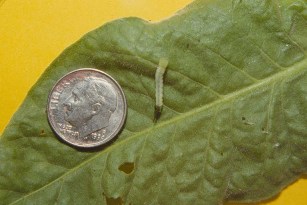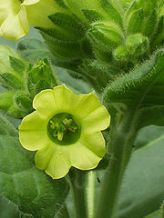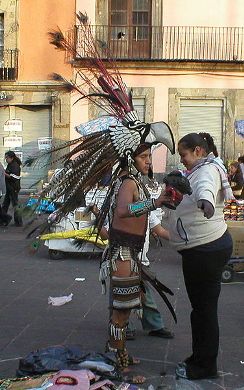
Interactions with Other Organisms
Tobacco Hornworm and Budworm

Tobacco plants act as a host for a few species of insects. The tobacco hornworm (Manduca sexta) and budworm (Heliothis virescens) feed on the plant. The tobacco hornworm is popularly found in the southern United States but does extend northward up to New York. They are mainly found to feed on the leaves of the plants. The tobacco budworm is found in the southwestern United States, New England, New York, and even southern Canada.
People
The herbal part of Nicotiana tabacum is used for medicinal purposes. The active chemicals that Nicotiana tabacum possess are nicotine and other alkaloids. It is a traditional Central and South American medicine used to treat constipation and anthelmintic. The chemicals in tobacco leaves were also used to make insecticidals.
Medicinal uses back in 1675
Immigrants: Early immigrants into the
United States used the herb in tobacco to help digestion,
toothaches, and infection. It was also learned from the
natives that it heated them that were cold and cooled them that
sweat, meaning it was used to treat colds and fevers.
Native Americans: Tobacco was most often used as a painkiller for various aches and pains. Crushed leaves were applied to treat swelling and open wounds just like the Hibiscus rosa-sinensis is used for. The leaves were also chewed up and applied to treat rattlesnake bites. The main medicinal use of tobacco was that it alleviated pain just like aspirin which is the product of the White Willow.
 “In ancient times, when the land was barren and
the people were starving, the Great Spirit sent forth a woman to
save humanity. As she travelled over the world everywhere her right
hand touched the soil, there grew potatoes. And everywhere her left
hand touched the soil, there grew corn. And in the place where she
had sat, there grew tobacco.” Huron Indian myth “The Spaniards upon
their journey met with great multitudes of people, men and women
with firebrands in their hands and herbs to smoke after their
custom.”
“In ancient times, when the land was barren and
the people were starving, the Great Spirit sent forth a woman to
save humanity. As she travelled over the world everywhere her right
hand touched the soil, there grew potatoes. And everywhere her left
hand touched the soil, there grew corn. And in the place where she
had sat, there grew tobacco.” Huron Indian myth “The Spaniards upon
their journey met with great multitudes of people, men and women
with firebrands in their hands and herbs to smoke after their
custom.”
-Christopher Columbus’
journal, 6 November 1492
(Taken from
tobacco-facts.net)
Other Organisms
 Mutualism: Tobacco is prone to forming a
mutualistic relationship with fungi in the phylum Glomeromycota.
Fungi in this phylum are known for their ability to form endomycorrhizae with about 90% of plants. This is coined a mutualistic relationship because the fungi provides the plant with
its absorbing abilities in order to acquire more nutrients to help it
grow much better. The plant provides the fungi with necessary
sugars such as glucose. Tobacco also forms a mutualistic
relationship with earth worms.
Earth worms
feed on the dead material in the soil composting the material making
the soil more fertile for the tobacco to grow. The tobacco
provides the worms food when they perish and decompose into the
soil.
Mutualism: Tobacco is prone to forming a
mutualistic relationship with fungi in the phylum Glomeromycota.
Fungi in this phylum are known for their ability to form endomycorrhizae with about 90% of plants. This is coined a mutualistic relationship because the fungi provides the plant with
its absorbing abilities in order to acquire more nutrients to help it
grow much better. The plant provides the fungi with necessary
sugars such as glucose. Tobacco also forms a mutualistic
relationship with earth worms.
Earth worms
feed on the dead material in the soil composting the material making
the soil more fertile for the tobacco to grow. The tobacco
provides the worms food when they perish and decompose into the
soil.

Predation/infestation: Tobacco has many pests that are known to infect and feed on the plant resulting in less production of the crop. Some of these pests and predators include cutworms, wireworms, crambids, hornworms, budworms, tobacco flea-beetle, mole crickets, grasshoppers, tobacco thrips, green june-beetle, cigarette beetle, and the tobacco moth. Monarch butterflies in their larval form tend to also infest the plant. Tobacco shares many of these pests and predators with the Yellow Ladyslipper Orchid.



Now that we have explored the various interactions that tobacco is involved in, click here to learn about how this amazing plant undergoes reproduction!
Logan Van Hoof, April 2011